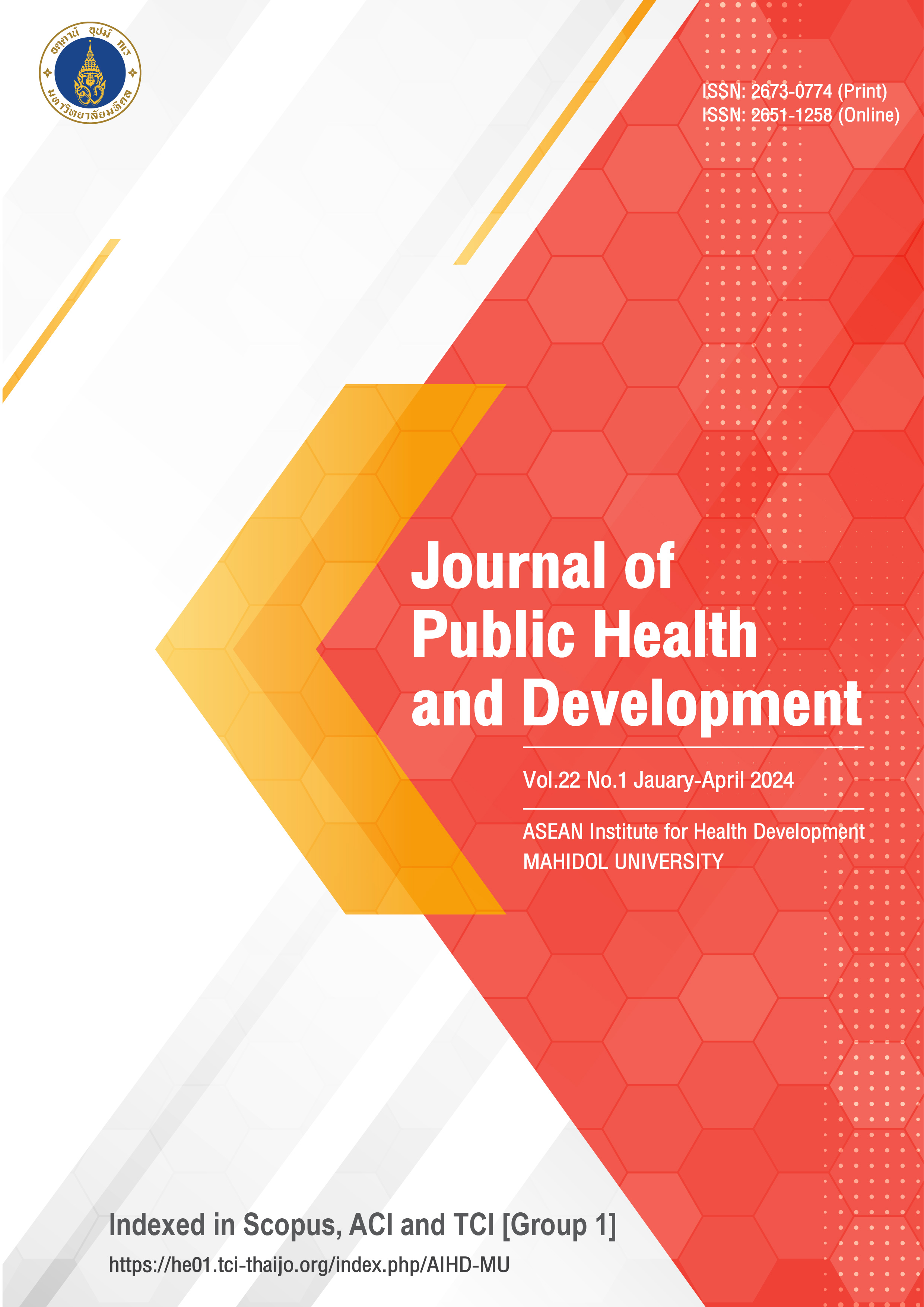Factors affecting preventive behaviors for unplanned pregnancy in female high school students 10.55131/jphd/2024/220121
Main Article Content
Abstract
This cross-sectional study aimed to study the factors affecting preventive behavior for unplanned pregnancy in female high school students. The participants were 498 high school students selected through multi-stage sampling and the sampling of random students from the specified educational levels of Grades 10, 11, and 12 was conducted by using the following inclusion criteria: be a student aged 15-18 years; be a student attending Grade 10, 11, or 12. The data were analyzed by using mean, standard deviation, and binary logistic regression.
The results showed that seven factors affected behavior concerning unplanned pregnancy in female high school students including: the educational levels in Grade 12 (OR = 10.65, 95% CI = 1.35 - 83.50), the latest GPA ≥ 3.51 (OR = 9.00, 95% CI = 1.45 - 55.99), the knowledge of birth control (OR = 22.12, 95% CI = 2.43 - 201.81), the attitude toward birth control and pregnancy prevention (OR = 4.15, 95% CI = 1.38 - 12.43), perception of the risk of pregnancy from sexual relationships (OR = 3.79, 95% CI = 1.56 - 9.21), the perception of self-efficacy to prevent pregnancy (OR = 5.31, 95% CI = 2.89 - 9.73), and the self-esteem (OR = 4.24, 95% CI = 1.87 - 9.61). These factors had a 79.10% chance of predicting unplanned pregnancy preventing behaviors in high school students. This study suggests that schools or related organizations should develop health education programs for preventing unplanned pregnancies including knowledge, attitudes, self-efficacy, and self-esteem.
Article Details

This work is licensed under a Creative Commons Attribution-NonCommercial-NoDerivatives 4.0 International License.
References
World Health Organization. Adolescent Pregnancy. [Internet]. 2014 [cited 2018 Jun 12]. Available from: http://www. who.int/news-room/fact-sheets/detail/ adolescent-pregnancy.
World Health Organization. Adolescent Pregnancy. [Internet]. 2023 [cited 2023 Dec 27]. Available from: https://www. who.int/news-room/fact-sheets/ detail/adolescent-pregnancy.
Finer LB, Zolna MR. Shifts in intended and unintended pregnancies in the United States, 2001–2008. Am J Public Health. 2014;104(Suppl1):S43-S48. doi: 10.2105/ AJPH.2013.301416.
Sedgh G, Singh S, Henshaw SK, Bankole A. Legal abortion worldwide in 2008: levels and recent trends. Perspect Sex Reprod Health. 2011;43(3):188-98. doi: 10.1363/3708411.
Chandra-Mouli V, Camacho AV, Michaud PA. WHO guidelines on preventing early pregnancy and poor reproductive outcomes among adolescents in developing countries. J Adolesc Health. 2013;52(5):517-22. doi: 10.1016/j.jadohealth.2013.03.002.
World Health Organization. Adolescent birth rate (per 1000 women aged 15-19 years) of ASEAN countries [Internet]. 2022 [cited 2023 Mar 23]. Available from: https://data.worldbank.org/ indicator/SP.ADO.TFRT?end=2020&ASEAN.
Bureau of Reproductive Health DoH, Ministry of Public Health. Situation of Reproductive Health in Adolescents and Youths in 2018-2021 [Internet]. 2020 [cited 2023 Mar 23]. Available from: https://rh.anamai.moph.go.th/th/cms-of-1.
Bureau of Reproductive Health DoH, Ministry of Public Health,. Situation of Reproductive Health in Adolescents and Youths in 2019 [Internet]. 2020 [cited 2023 Mar 23]. Available from: https:// rh.anamai.moph.go.th/th/cms-of-1.
Wongsawat P. Course Handout on Sample Size Determination (Descriptive Research). Phitsanulok: Faculty of Public Health, Naresuan University; 2017.
Rovinelli RJ, Hambleton RK. On the use of content specialists in the assessment of criterion-referenced test item validity. Dutch J Educ Res. 1977;2:49-60.
Cronbach LJ. Essential of Psychology and Education. New York: McGraw Hill; 1984.
Bloom BS. Taxonomy of Education Objective, Handbook I: Cognitive Domain. New York: David McKay; 1975.
Tabachnick BG, Fidell LS. Using Multivariate Statistics. 6th ed. Boston: Person Education; 2012.
Tumchuea S. Sexual behaviors and factors correlated with the intention of protection. Nurs. J Ministry Publ Health. 2015;25(1):97-109.
Wattanathamrong V, Sirisopon N, Kainakha P, Onsiri S, Amitpie C, Anek A, Napatpittayatorn P, Polsron K. Factors related intention contraception type implants in repeat pregnancies in adolescents. J Royal Thai Army Nurses. 2017;18(Suppl1):102-11.
Homsin P. Concepts and Theories for Practice: Smoking and Alcohol Drinking Prevention Among Adolescents. Chonburi: Chonburi Printing House; 2015
Suvarnakuta P, Congkhaow T, Nung-Alee S. The effect of promoting communication about sex program on feeling comfortable and practice in communication about sex between early female adolescents and mothers. JONAE. 2017;10(4):63-75.
Chopra S, Dhaliwal L. Knowledge, attitude and practices of contraception in urban population of North India. Arch Gynecol Obstet. 2010;281(2):273-77. doi: 10.1007/s00404-009-1096-y.
Namprai P. Knowledge and attitude of pregnancy prevention of High School Students in Chantarubeksaanuson School Kaset Wisai Subdistrict, Kaset Wisai District, Roi Et Province. MKHJ. 2017;14(3):67-75.
Jantarasiew B, Boonyaporn T. Teenage mothers in post partum period at Trang Hospital: attitudes, subjective norms, perceived behavioral control, and intention to use contraception. SCNJ. 2019;6(1):143–53.
Nsubuga H, Sekandi JN, Sempeera H, Makumbi FE. Contraceptive use, knowledge, attitude, perceptions and sexual behavior among female university students in Uganda: A cross-sectional survey. BMC Women's Health. 2015;16(6):1-11. doi: 10.1186/s12905-016-0286-6.
Nithitantiwat P, Pataipakaipet K. Unwanted pregnancy and abortion: preventive guidelines for adolescents. JBCH_Bangkok. 2016;32(2):133-46.
Rojruangnon P, Nititham A, Teravecharoenchai S. Factors related to preventive behaviors of unexpected pregnancy among the female undergraduates, Bangkok Metropolitan. J Sci Technol MSU. 2017;36:194-02.
Intharueng U, Masingboon K, Wacharasin C. A causal model of contraceptive behavior among female adolescents. J Nurs Health Care. 2015; 33(4):43-53.
Basri R, Deoisres W, Suppaseemanont W. Factors predicting contraceptive use among women seeking induced abortion in Dhaka, Bangladesh. Thai Pharm Health Sci J. 2014;9(2):75-81.
Arsandaux J, Montagni I, Macalli M, Bouteloup V, Tzourio C, Galéra C. Health Risk Behaviors and Self-Esteem Among College Students: Systematic Review of Quantitative Studies. Int J Behav Med. 2020;27(2)






